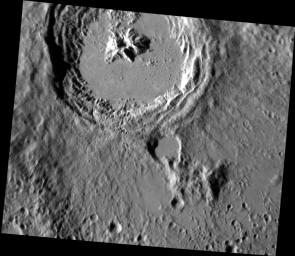
|
The Kuiper Melt
- Click the image above for a larger view
- Full-Res JPEG (1313 x 1139) (185.8 kB)
- Full-Res TIFF (1313 x 1139) (1.5 MB)
Caption:
This striking image of Kuiper shows the crater in a new perspective. This image highlights the crater's smooth impact melt and central peaks . Kuiper, first seen by Mariner 10, is an easily identifiable feature on Mercury's surface due to its bright rays, similar to Hokusai .
This image was acquired as a high-resolution targeted observation. Targeted observations are images of a small area on Mercury's surface at resolutions much higher than the 200-meter/pixel morphology base map. It is not possible to cover all of Mercury's surface at this high resolution, but typically several areas of high scientific interest are imaged in this mode each week.
Date acquired:
April 05, 2013
Image Mission Elapsed Time (MET) (
since January 8, 2013
):
7447880
Image ID:
3823149
Instrument:
Narrow Angle Camera (NAC) of the Mercury Dual Imaging System (MDIS)
Center Latitude:
-12.07°
Center Longitude:
328.9° E
Resolution:
85 meters/pixel
Scale:
Kuiper has a diameter of ~62 kilometers (39 miles)
Incidence Angle:
69.2°
Emission Angle:
32.7°
Phase Angle:
102.0°
Background Info:
The MESSENGER spacecraft is the first ever to orbit the planet Mercury, and the spacecraft's seven scientific instruments and radio science investigation are unraveling the history and evolution of the Solar System's innermost planet. MESSENGER acquired over 150,000 images and extensive other data sets. MESSENGER is capable of continuing orbital operations until early 2015.
For information regarding the use of images, see the MESSENGER image use policy .
Cataloging Keywords:
| Name | Value | Additional Values |
|---|---|---|
| Target | Mercury | |
| System | ||
| Target Type | Planet | |
| Mission | MESSENGER | Mariner |
| Instrument Host | MESSENGER | Mariner 10 |
| Host Type | Orbiter | Flyby Spacecraft |
| Instrument | Mercury Dual Imaging System (MDIS) | |
| Detector | Narrow Angle Camera (NAC) | |
| Extra Keywords | Crater, Grayscale, Impact, Map, Radio | |
| Acquisition Date | ||
| Release Date | 2013-06-10 | |
| Date in Caption | 2013-01-08 | 2013-04-05 |
| Image Credit | NASA/Johns Hopkins University Applied Physics Laboratory/Carnegie Institution of Washington | |
| Source | photojournal.jpl.nasa.gov/catalog/PIA17238 | |
| Identifier | PIA17238 | |
